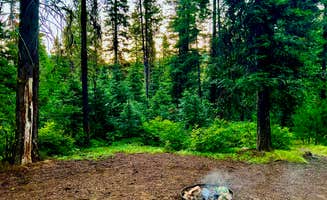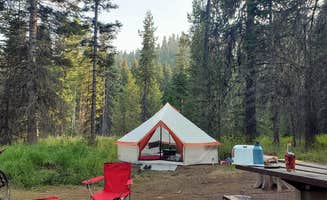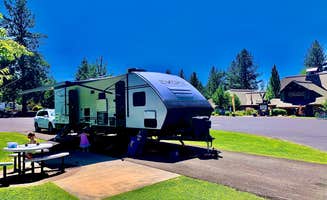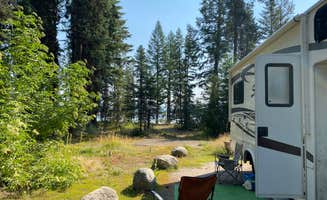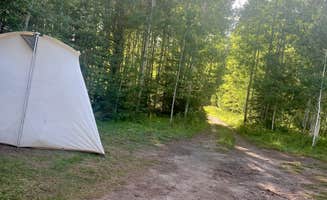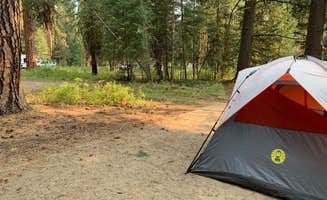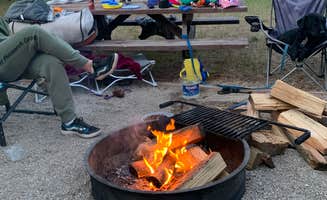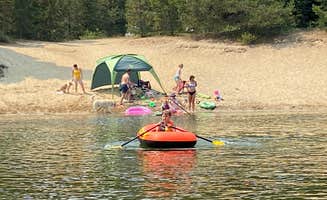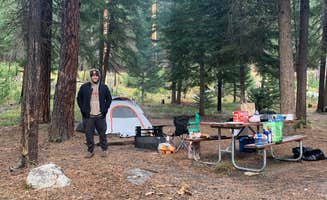Camping near Spink, Idaho encompasses varied terrain across elevations ranging from 4,800 to 5,200 feet, creating significant temperature variations even during summer months. Nighttime temperatures can drop into the 30s in higher elevation sites through July, requiring campers to pack appropriate cold-weather gear regardless of season. Most dispersed camping areas close by mid-October due to snowfall that can persist until late May.
What to do
Hiking to waterfalls: Last Chance Campground provides access to Goose Creek Falls via a well-maintained 2.8-mile trail. "The trail is exceptionally well designed and has boardwalks over muddy stretches. I highly recommend both the campground and hike!" notes Gretchen B. The trail features wildflowers in June when water flows are highest.
Hot springs exploration: Several natural hot springs are accessible near Last Chance Campground. "The best hot spring locates a short distance from the campground. This is one of my favorite places to camp. The trees around gave us plenty of shade on a hot day!" reports Simran D. The springs are approximately a 15-minute walk from the campground.
Winter recreation: Some campgrounds maintain seasonal operations for snow activities. "In the winter, the park offers great snowshoe trails, and groomed trails for cross-country skiing and skate skiing," explains Hannah C. about Ponderosa State Park Peninsula. Many campgrounds that close for overnight stays still maintain day-use winter access.
What campers like
Lake access for paddlers: Multiple campgrounds offer direct water access for non-motorized craft. "We had paddle boards, a canoe, and a floatie and spent the entire day out there. There was some nice sand for the kids to build with," shares Tara L. about Sugarloaf Campground, noting the less crowded atmosphere at the lake's end.
Wildlife viewing: Campgrounds frequently report wildlife encounters. "We even had 3 baby foxes visit our camp one evening. I could see it getting crowded on weekends, but I had this all to myself on a Monday and Tuesday," recounts Simran D. at Sugarloaf Campground. Bird watchers particularly note osprey, pelicans, and mountain bluebirds around Lake Cascade.
Huckleberry picking: Several camping areas provide seasonal berry access. "This is a great place to access Goose Creek Falls. A great hike for the family. It is also a good place to pick Morels in the spring and Huckleberries in the summer!" explains Hannah C. Huckleberries typically ripen from late July through August, with peak picking in early August.
What you should know
Bear awareness required: Food storage protocols are essential at most campgrounds. "Because of the proximity to water and the road you will need to haul in your own firewood. If you have a 4x4 there are a couple of forest roads on the other side that you can drive up to gather wood... Because of this there is a bear warning for the campgrounds," advises Jamie H. about Amanita Campground.
Insect preparation: Mosquitoes present a significant challenge at many sites, particularly near lakes and in early summer. "Horrible mesquitoes. We may be packing up to leave early. Beautiful space though," reports Imerie T. at Little Payette Lake dispersed camping area. Repellent is considered essential equipment from May through August.
Road conditions: Access to dispersed camping requires preparation. "The road up to this campground isn't bad but it is gavel and steep," notes Tom K. about Last Chance Campground. Many forest roads become impassable during spring snowmelt or after rainfall, requiring high-clearance vehicles or alternative planning.
Tips for camping with families
Beach access considerations: Beach quality varies significantly between campgrounds. "The beach at the lake is lovely. Site #7 backs up to a large beach area," recommends Heidi C. about Rainbow Point. Sites with direct lake access fill first, often requiring reservations 6-9 months in advance for summer weekends.
Playground alternatives: When campgrounds lack dedicated play structures, natural features provide alternatives. "Lots of trails all over to walk the dogs on," mentions Jessica C. about Ponderosa State Park Peninsula. Many campers note that fallen logs and shallow shorelines create natural play areas for children.
Quiet time enforcement: Family-friendly atmosphere depends on campground management. "The rangers do not enforce the quiet hour rule and you get woken up in the middle of the night by screaming kids," cautions Jamie H. about Ponderosa State Park. Families seeking reliable quiet hours might consider smaller Forest Service campgrounds with active hosts.
Tips from RVers
Amenity trade-offs: RV-friendly campgrounds offer varying levels of services. "Older place has power and water and a central dump station," explains Jeff K. about Black Bear RV Park. Some RVers note that smaller campgrounds with fewer amenities offer significantly more space between sites.
Site privacy: Campground layouts vary significantly in terms of privacy. "Sites are spaced far apart and very spacious. Campground host is great and the campground is clean. There are a few pull throughs which make it easy for RVs," notes Heidi C. about Rainbow Point. Full-hookup sites typically offer less privacy than partial-hookup or dry camping options.
Off-season advantages: Shoulder season camping provides better availability. "End of Season, so it was not crowded. Sites are spacious. Views of Lake, bathrooms are clean," reports Denise F. about Poison Creek Campground. Most RV sites remain accessible from early May through mid-October, with reduced rates in spring and fall.


